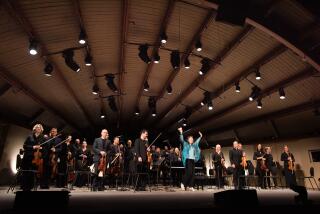MUSIC REVIEWS : Bach Salvages Baroque Keyboard Program
- Share via
It seemed entirely appropriate, during the first half of Brazilian harpsichordist Ilton Wjuniski’s recital Wednesday night, that we were sitting in a museum.
For, what on paper had looked piquant--exotic offerings by William Byrd, Vieux Gaultier-J. H. d’Anglebert and Francois Couperin--was turning out to be as dry as dust in the telling, as petrified as any dinosaur bone in the tar pits nearby (the concert being in Bing Theater of the L.A. County Museum of Art).
But then the second half arrived and, well, it was Bach. What a relief. And something of a revelation.
In his program notes for this concert devoted to harpsichord dance suites, Wjuniski pointed out that most of the music was, basically, undanceable. He then apparently set out to prove it.
Byrd’s tightly woven Passamezzo, Pavan and Galliard would occasionally break out into an improvisatory flourish or something Italianate, and just as quickly to return to its imperturbable, almost impenetrable way.
The Suite by Gaultier-d’Anglebert (the latter composer transcribing the former’s lute music) proved equally tough going: grayish, 17th-Century formalism. And what are modern ears to make of the four pieces from Couperin’s “Second Ordre” (Book I, 1713), whose main purpose seemed a chirping ornamentation between parts, back and forth like a couple of love-struck beetles?
Certainly the large size of the hall had something to do with the ineffectiveness of the first half; this intimate, subtle, uncolored music is difficult to enter into in such a setting.
With Bach’s French Suites Nos. 4 and 5, however, we were suddenly in a world of melody, action, vital harmony, and all was well. The leaping bass lines startled, invigorated. It was like turning to Shakespeare after a week with the phone book.
And Wjuniski revealed himself an inspired Bach interpreter, creating tension between lines by voicing them equally, by phrasing them lyrically and by giving them a rhythmic independence from each other.
To decidedly more vigorous applause than was accorded the first half, the harpsichordist offered Mozart’s Rondo in D, K. 485, in encore.
More to Read
The biggest entertainment stories
Get our big stories about Hollywood, film, television, music, arts, culture and more right in your inbox as soon as they publish.
You may occasionally receive promotional content from the Los Angeles Times.










